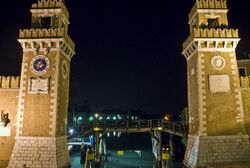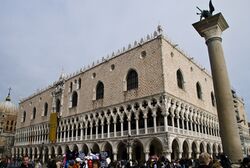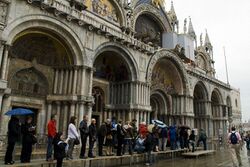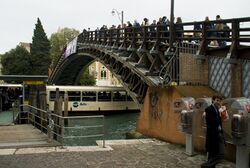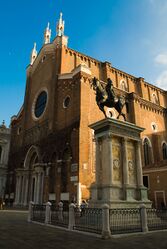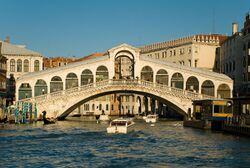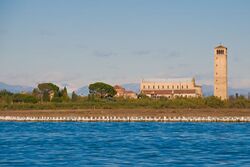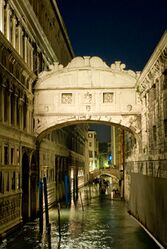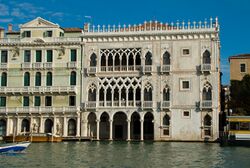Wikimecum:History questions
Jump to navigation
Jump to search
This is a list of questions that students going to Venice should know the answers to.
|
This page is: FINALIZED. Questions will no longer change. |
A randomized, multiple-choice test is available on myWPI. As with the Italian tests, you are allowed to take the test multiple times and consult your information sources while doing so.
However, there will also be a closed-book test given in class during A Term that will require you to have actually learned and memorized the answers to these questions.
Answers to all of these questions can be found using Google, these resources at the WPI Library, the two books posted on myWPI under "History", and these PowerPoints from previous years. Useful links also accompany some of the questions.
History
- Who were the Veneti?
- Historically, the Winged Lion of Saint Mark was the symbol most commonly used by Venice to represent itself in affairs of state. Why did Venice select this symbol?
- There is a Latin motto that appears on virtually all images of the winged lion: PAX TIBI, MARCE, EVANGELISTA MEUS. What does this motto mean, and where did it supposedly originate?
- Saint Mark (the Evangelist) is Venice's current patron saint. What original patron saint did he replace, and in what year? Where can representations of these patron saints be found side by side in Venice today?
- A "relic" is an item of religious significance, typically kept in a church as something to be revered and visited by pilgrims. The most common type of relic is the body of a saint (or parts thereof). What notable relics can be found in Venice, and where?
- The Venetian lagoon first began to be occupied in the 5th century A.D. Name two early Venetian lagoon settlements that existed prior to the founding of the present city of Venice.
- How old is the cathedral on Torcello?
- In what year was Venice founded?
- The Byzantine Empire provided a significant amount of influence on early Venetian government, art, and architecture. Identify some buildings, artworks and other tangible evidence of Byzantine influence still visible in Venice today.
- "La Serenissima" is an Italian expression often used to refer to the Venetian Republic. What does it mean, and why is this expression often associated with Venice?
- In what manner was corruption prevented in the Venetian government (i.e., how were doges elected)?
- What is a doge? How long was his mandate? Who was the alleged first doge, and when?
- The Venetian mint was a powerful institution in European trade during the Middle Ages. What was the name of the gold coin it issued?
- What role did Venice play during the fourth crusade?
- The Arsenale was the center of Venetian military might. In its heyday, what was it best known for?
- Explain the Venetian significance/origin of each of these modern terms:
- arsenal
- ciao
- ghetto
- gondola
- lido
- quarantine
- regatta
- @ (the "at" symbol)
- The metal piece on the front of a gondola is called a ferro. What was its role and significance? Historically, what role did the gondola play in Venice?
- Today, the island of Murano is known for its tourist-oriented glass production. In its heyday, however, it was one of the major centers of European glass-making. Where is Murano, relative to Venice, and why was it selected as a place for glass-blowing workshops?
- What was the city of Venice's peak population? In what year? What was the population in the years 1200 and 1950? What is its population today?
- Trade made Venice a wealthy and powerful nation. Explain how its positioning (politically, geographically, culturally) made it so well-suited to this economic practice.
- Name three festivals historically celebrated in Venice each year. Are they still celebrated today? If so, on what dates?
- Every May, Venetians celebrate the Festa della Sensa. What historically took place during this feast, and why?
- The Festa della Madonna della Salute has taken place in Venice in late November since roughly 1630. Why?
- There is a "parallel" holiday to the Festa della Madonna della Salute, also celebrated annually to this day. What is it called?
- What role did the Scuole Grandi serve in Venice? How many were there?
- Along the Grand Canal in Venice today, you can visit the Fontego dei Turchi (now a natural history museum) and the Fondaco dei Tedeschi (now the Venice post office headquarters). What was a fontego/fondaco, and what role did they historically serve in Venice?
- How old was the Venetian Republic when it was overthrown? Who conquered the Venetian Republic, and in what year?
- It may surprise you to learn that the Venetian Republic co-existed with the United States as a political entity, and even made attempts at diplomatic relations. For how many years did the existences of the two nations overlap?
- What nation primarily occupied Venice in the 19th century?
- What significant, detrimental effect on the lagoon (and the city of Venice) did the nearby port of Marghera have in the 1950s?
- On November 4, 1966, Venice was hit by record-setting floods that left many parts of the city underwater. Name two or three outcomes (specific or general) as a result of this event,
Geography
- Venice is located in the Veneto region of Italy. What is this region known for? What regions neighbor the Veneto?
- On a more local scale, Venice is geographically situated in the middle of the Venetian lagoon. Roughly how old is the lagoon?
- Did the lagoon that exists today form naturally or with human intervention?
- The lagoon used to consist of little more than marshy patches of grass in the middle of shallow salty water. In fact, it still does in many places. What is the Venetian name for the lagoon's salt marshes?
- There are three inlets to the Venetian lagoon from the Adriatic Sea. What are the inlets' names? Be able to point them out on a map.
Architecture and Urban Landscape
- Venice is not a city built on a single island, but rather an agglomeration - almost an archipelago - of smaller islands. Roughly how many?
- Did the canals of Venice originally form naturally, or were they a Venetian engineering project that involved digging trenches across existing dry land?
- The Grand Canal in predominantly lined by palaces, or palazzi. What features typically characterize a Venetian palace?
- There is exactly one piazza in Venice. What is its name?
- What is the Venetian term for what would be called a piazza elsewhere in Italy? Where did this term originate?
- What was the original purpose for the belltower in Saint Mark's Square? What is the Italian word for "belltower"?
- What is the layout of a typical island making up part of the city of Venice?
- How many bridges are there over the Grand Canal? In what order were these bridges constructed? Make sure you use an up-to-date information source for your answer!
- What is the (ironic) name of the bridge connecting Venice to the mainland?
- In what shape is the Grand Canal, and why?
- Several landmarks are found at both ends of the Grand Canal. Be able to name some at both ends.
- On what kind of foundations are Venetian buildings built?
- Venice is divided into six sestieri (literally "sixths," but more generally "neighborhoods"). What are their names? Be able to label them on a map.
- What was/is the Venetian way of referring to a wealthy family's palace? Hint: Instead of calling it the "Palazzo So-and-so," Venetians call it the...
- What is the significance of Istrian marble to Venice? Where was Istria, and what is it known as today?
- The date of construction of the belltower in Saint Mark's Square would surprise many people. When was it built? Contrast this to the date of construction of the current Basilica di San Marco, which is...?
- Every night at midnight, a distinctive bell rings out from the belltower in Saint Mark's Square - you can hear it everywhere in Venice, especially because the city is so quiet at night. What is the name of this bell?
- In Venice, what is meant by a "squero"?
- What is the Doge's Palace? And the Basilica di San Marco? Be able to locate them on a map.
- Higgins House, on the campus of WPI, has a coat of arms of Venetian significance above its front door. Whose symbol is depicted on the carving, and what was the motto he used?
Today
- Name three general issues facing Venice today. What problems to they pose for the city?
- What is MOSE? Why is it controversial?
- Is Venice sinking?
- Boat wakes are problematic for Venice and its lagoon. What effect do they have on the city's urban and natural environments? What Italian phrase is used to refer to boat wakes?
- Where may Venetians be buried when they die?
- You may have periodically heard the term "acqua alta" used in North American news media, which loves to exaggerate the effect of this phenomenon. What is it, exactly?
- Name the three universities in Venice.
- The Biennale di Venezia is typically responsible for unusual pieces of modern art one can find scattered around the city. What is it?
- What are the three biggest cities/towns in the Veneto, by population?
- Roughly how many tourists visit Venice each year?
- Where is Venice's primary produce and fish market located?
- This is a tricky one: are there any cars in Venice?
- What is the closest city to Venice on the mainland?
- You should not buy the counterfeit products sold by illegal street vendors in Venice. Where do these goods come from?
- Be able to identify the buildings/structures/places shown in these pictures:
